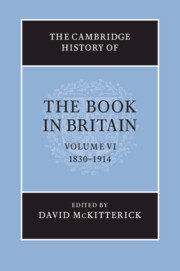Book contents
- Frontmatter
- Introduction
- 1 Changes in the look of the book
- 2 The illustration revolution
- 3 The serial revolution
- 4 Authorship
- 5 Copyright
- 6 Distribution
- 7 Reading
- 8 Mass markets: religion
- 9 Mass markets: education
- 10 Mass markets: children’s books
- 11 Mass markets: literature
- 12 Science, technology and mathematics
- 13 Publishing for leisure
- 14 Publishing for trades and professions
- 15 Organising knowledge in print
- 16 The information revolution
- 17 A place in the world
- 18 Second-hand and old books
- 19 A year of publishing: 1891
- 20 Following up The reading nation
- Bibliography
- Index
- Plate Sections
- References
20 - Following up The reading nation
Published online by Cambridge University Press: 28 March 2010
- Frontmatter
- Introduction
- 1 Changes in the look of the book
- 2 The illustration revolution
- 3 The serial revolution
- 4 Authorship
- 5 Copyright
- 6 Distribution
- 7 Reading
- 8 Mass markets: religion
- 9 Mass markets: education
- 10 Mass markets: children’s books
- 11 Mass markets: literature
- 12 Science, technology and mathematics
- 13 Publishing for leisure
- 14 Publishing for trades and professions
- 15 Organising knowledge in print
- 16 The information revolution
- 17 A place in the world
- 18 Second-hand and old books
- 19 A year of publishing: 1891
- 20 Following up The reading nation
- Bibliography
- Index
- Plate Sections
- References
Summary
In offering personal ideas on how the ‘history of the book’ might be developed in the future, I do not aim to survey the field or to suggest a comprehensive plan, but to set out possible ways forward which others can follow if they choose. I mainly offer examples from the long – until 1914–18 – nineteenth century in Britain, concentrating on literary texts, with some examples taken from two unpublished archival sources. I draw on the follow-up to my study of reading in the early nineteenth century Anglophone world, The reading nation in the Romantic period (2004) that has been the subject of many reviews, seminars, interrogations, blogs and personal communications. Scholarly interest has focussed both on the findings for that period and on how the approach might be developed, added to, and modified for potential use in addressing other research questions; for example, how far it would be applicable in other reading nations. There has been much interest too in how my emerging models of the links between texts, books, prices, access, timing of access, readerships and consequences – ‘the political economy of reading’ – may be applicable to current public policy issues, notably those relating to intellectual property. The follow-up, that is ongoing, although focussed on that one book, has therefore enabled a wide debate to occur about the traditions, limitations, aims and opportunities of ‘book history’ as a whole. My first suggestion is that book historians should be more ambitious.
Keywords
- Type
- Chapter
- Information
- The Cambridge History of the Book in Britain , pp. 704 - 735Publisher: Cambridge University PressPrint publication year: 2009
References
- 1
- Cited by

